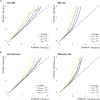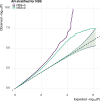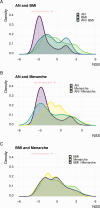An evolutionary perspective on the genetics of anorexia nervosa
- PMID: 39971893
- PMCID: PMC11840024
- DOI: 10.1038/s41398-025-03270-1
An evolutionary perspective on the genetics of anorexia nervosa
Abstract
Anorexia nervosa (AN) typically emerges around adolescence and predominantly affects females. Recent progress has been made in identifying biological correlates of AN, but more research is needed to pinpoint the specific mechanisms that lead to its development and maintenance. There is a known phenotypic link between AN, growth and sexual maturation, yet the genetic overlap between these phenotypes remains enigmatic. One may hypothesize that shared factors between AN, energy metabolism and reproductive functions may have been under recent evolutionary selection. Here, we characterize the genetic overlap between AN, BMI and age at menarche, and aimed to reveal recent evolutionary factors that may help explain the origin of AN. We obtained publicly available GWAS summary statistics of AN, BMI and age at menarche and studied the polygenic overlap between them. Next, we used Neandertal Selective Sweep scores to explore recent evolutionary selection. We found 22 loci overlapping between AN and BMI, and 9 loci between AN and age at menarche, with 7 of these not previously associated with AN. We found that loci associated with AN may have been under particular evolutionary dynamic. Chronobiology appeared relevant to the studied genetic overlaps and prone to recent evolutionary selection, offering a promising avenue for future research. Taken together, our findings contribute to the understanding of the genetic underpinning of AN. Ultimately, better knowledge of the biological origins of AN may help to target specific biological processes and facilitate early intervention in individuals who are most at risk.
© 2025. The Author(s).
Conflict of interest statement
Competing interests: The authors declare no competing interests. Ethics approval and consent to participate: Data collection for each GWAS was performed with participants’ written informed consent and with approval by the respective local Institutional Review Boards, as specified in the respective studies. All methods were performed in accordance with the relevant guidelines and regulations.
Figures





References
MeSH terms
Grants and funding
LinkOut - more resources
Full Text Sources

